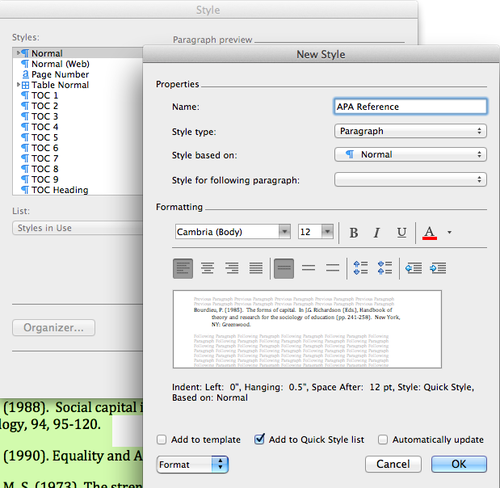
- SHORTCUT ON MAC FOR INDENT ON WORD MAC OS X
- SHORTCUT ON MAC FOR INDENT ON WORD ARCHIVE
- SHORTCUT ON MAC FOR INDENT ON WORD WINDOWS 7
- SHORTCUT ON MAC FOR INDENT ON WORD ZIP
I've just submitted a ticket regarding this. But what I'm saying is that doesn't look good to modify the behavior for such keystrokes without providing a substitute. If youre removing several instances of bullets just remove the first one then position the cursor over the next one(s) and press F4, this repeats. I agree with you about the TAB use in Word/TextEdit & Co. That's because the behavior of the kb shortcuts has changed in (one of) the last version(s) and the developers probably didn't realize the problem, otherwise they would have changed the mentioned menu.
SHORTCUT ON MAC FOR INDENT ON WORD MAC OS X
Your thoughts? This is a bug because the behavior is not as declared by Evernote itself, just check (in the Mac OS X version) the menu 'Format > Lists > Increase/Decrease List Level' and you can realize how the keyboard shortcuts suggested there are plain wrong. So, for Evernote, maybe a good design is for TAB to indent if in a list, and CTRL-TAB to move to the next cell.
SHORTCUT ON MAC FOR INDENT ON WORD ZIP
First up is ZIP one of the most commonly used compression techniques used across all platforms. File and folder compression saves on file size and ensures the contents are captured and delivered or stored as one monolithic file.
SHORTCUT ON MAC FOR INDENT ON WORD ARCHIVE
Well, making a zip archive on a Mac is easy, and with the compression tools built directly into OS X there is no need to download additional software or Opening zip files is even easier, all you need to do is just double-click on the archive and it will expand automatically with Archive Utility in the same. Seems like I remember CTRL-TAB used to do this, but it doesn't now.

Then it increases the indent.Ĭouldn't find a keystroke to move to the next cell if you in a list in a cell. Just tested TextEdit, and TAB moves to the next cell, unless the cursor is in a list. TAB has been used in tables in Word (Mac and Win) for a long time to move to the next cell, even if cursor is in a list. Your thoughts? I'm not sure this is a bug. These days 1/2 inch is considered proper (about 5 spaces using 12point Courier, but it will vary with other fonts and sizes).Somewhere in your Word Processing program, in your Formatting andparagraph settings, you'll be able to set the tab stops. In the Left or Right box, enter a negative number, and then on the Special pop-up menu, click Hanging. On the Ruler at the top of the screen, the first-line indent marker (the marker pointing down toward the text) will move to the right by inch. Place your cursor at the very beginning of the paragraph you want to indent. This will create a first-line indent of inch. On the Special pop-up menu, click Hanging. The quickest way to indent is to use the Tab key. On the Special pop-up menu, click First line. On the Mac, Ctrl+M and Cmd+Shift+Tab also work.
SHORTCUT ON MAC FOR INDENT ON WORD WINDOWS 7
However, The application switcher in Windows 7 seems to conflict with these shortcuts. On Windows, you can sometimes use Ctrl+Alt+Tab to indent and Ctrl+Alt+Shift+Tab to un-indent. This shortcut increases the indent in a cell by one step each time it is used. It is rare toever need to change the default setting.

Just hitting tab usually works, provided that a) you have a tab key(and who doesn't? Even ol d typewriters have tab keys), and b) it isset for the proper spacing as the default setting. If you prefer, use the space bar and tapit 5 times. If you are doingit on a computer, then just press the tab button, which is set tothe default of 5 spaces. You can also use Shift+Ctrl+T to undo your indent by one tab stop.Īs you can see it looks much more polished and is easier to read if you do not have look back to the margin when the paragraph wraps around.If you write by hand, then do two finger spaces.Each press of the shortcut indents the hang one more tab stop. If there are no explicit tab stops in your paragraph, Word will indent to the next default tab stop, which is usually one-half inch. Click Ctrl+T, which will hang your paragraph to the next tab stop.If you like to like to save time and keystrokes like I do, you might like to learn to format a paragraph to use a hanging indent just by using a keyboard shortcut. It keeps all your information aligned and makes it much easier for your reader to access. Hanging indents are common formatting in many documents and for good reason. A hanging indent is created when the first line of your paragraph starts at the left margin but the second and subsequent lines are indented from the left margin.


 0 kommentar(er)
0 kommentar(er)
